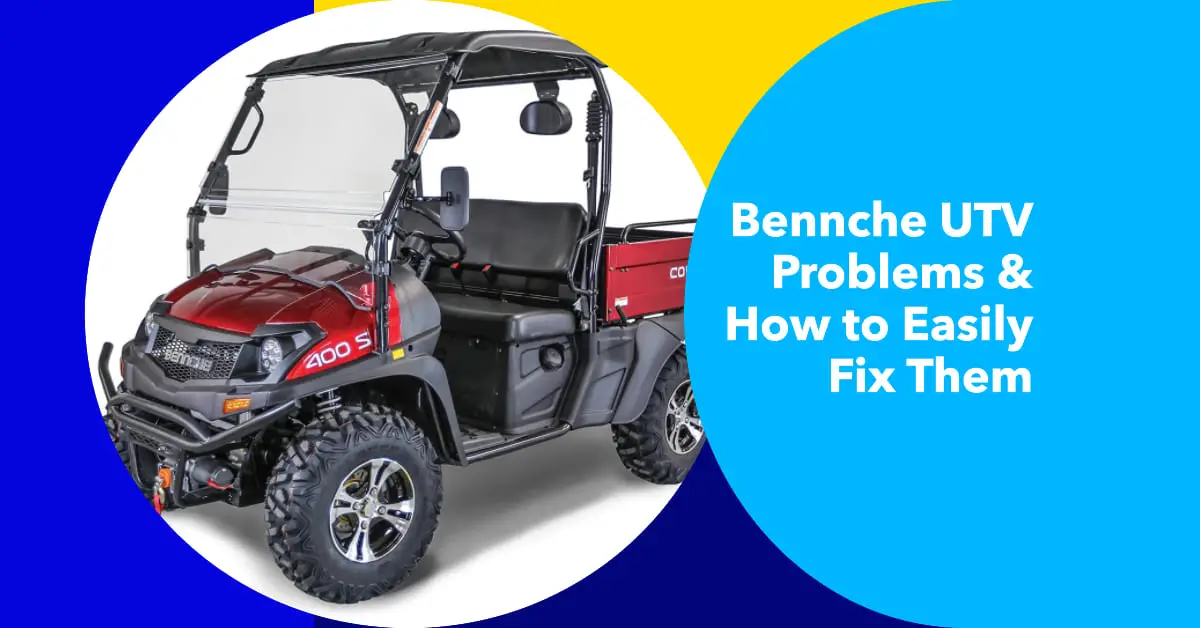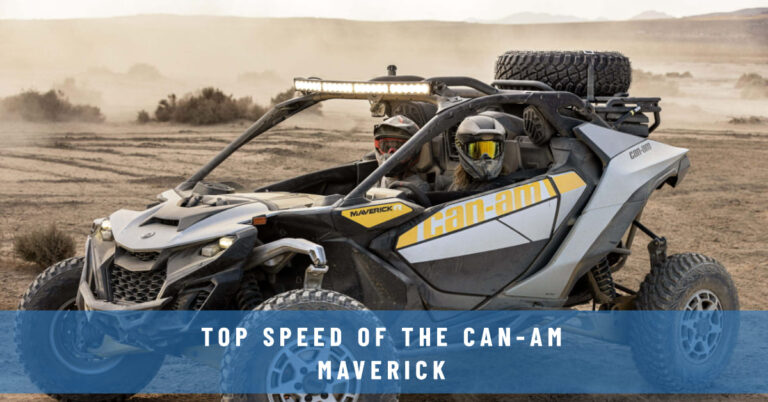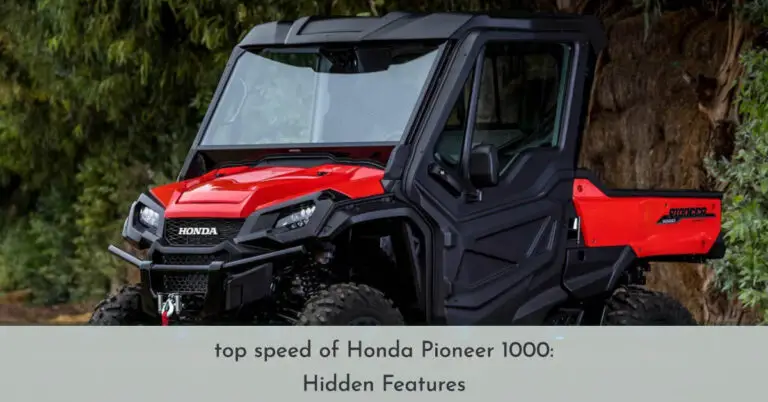Bennche UTV Problems & How to Easily Fix Them

So you just bought a Bennche UTV or are considering one, but aren’t sure about their reputation for reliability. Will it leave you stranded on the trails or in need of costly repairs?
The good news is most common Bennche UTV problems are relatively easy to diagnose and fix yourself. With some basic mechanical skills and tools, you can troubleshoot issues and perform repairs at home, saving time and money.
In this post, you’ll learn the most common problems Bennche UTV owners face and simple DIY fixes to get you back on the trails. We’ll cover:
- Engine problems like overheating, loss of power, and hard starting
- Drivetrain issues including clutch, belt, and shifting problems
- Electrical gremlins – no spark, blown fuses, and charging system faults
- Braking and suspension problems from worn pads to leaky shocks
- Quick tips to identify the root cause of problems
- Preventative maintenance to avoid issues in the first place
Arm yourself with the knowledge to handle Bennche UTV repairs and you’ll gain confidence in the machine’s reliability. Let’s get started diagnosing those bugs!
Table of Contents
Common Bennche UTV Engine Problems
The engine is the heart of your UTV. Unfortunately Bennches are prone to their share of engine problems ranging from minor fixes to more involved repairs. Here are some of the most common engine issues and solutions.
Overheating
Operating temperatures creeping into the red zone on your gauge cluster? There are a few key things that can cause a Bennche to overheat:
- Plugged radiator fins – Mud and debris easily clogs the radiator cooling fins. Clean them out with a spray of water or compressed air.
- Faulty radiator cap – The cap needs to hold pressure in the cooling system. Replace it if it’s not sealing properly.
- Low coolant levels – Check the overflow tank and top up with the recommended 50/50 antifreeze mix if low.
- Faulty water pump – The water pump circulates coolant. Replace it if the bearing is shot or leakage occurs.
- Stuck thermostat – The thermostat regulates coolant flow. Replace it if stuck closed and not allowing coolant to flow into the radiator.
Overheating can lead to severe engine damage if left unchecked. Address any cooling issues right away to avoid costly repairs.
Loss of Power
A Bennche UTV losing power makes riding less fun. Lack of power on acceleration or hills can be caused by:
- Dirty air filter – Check the air filter element and clean or replace it if clogged with dirt. Restricted airflow reduces power.
- Plugged fuel filter – A restricted fuel filter stops proper fuel flow to the injectors. Swap it out if it’s plugged.
- Fouled spark plugs – Inspect the plugs for heavy carbon deposits or wear. Clean or replace them as needed to restore full ignition spark.
- Low compression – Compression issues from worn piston rings or leaky valves can rob power. A leakdown or compression test can verify.
Don’t put up with a lackluster engine. A close inspection of the air, fuel and ignition systems will reveal the real cause.
Hard Starting
A Bennche that cranks over but won’t start or takes excessive cranking to get running may have:
- Weak battery – Slow cranking and intermittent operation signals a worn out battery. Check terminals are tight and load test the battery.
- Clogged fuel filter – No fuel equals no start. As mentioned above, replace the fuel filter if flow is restricted.
- Fouled spark plugs – Check for blackened or oil fouled spark plugs. Fresh plugs ensure solid ignition spark.
- Faulty starter – Starters do eventually fail. Hit it with 12 volts directly to verify cranking speed, replacing it if needed.
- Poor carburetor adjustment – Issues like out of adjustment floats prevent starting. Carb rebuilding may be required.
Don’t keep kicking away at the starter motor. Diagnose and remedy causes of hard starting to avoid damaging components.
Common Bennche UTV Drivetrain Problems
It takes a proper functioning drivetrain to put the engine’s power to the ground. Clutch, belt, transmission and other driveline problems can quickly halt any ride.
Slipping Clutch
A Bennche slipping out of gear has the clutch to blame. Here’s how to get back to hooking up:
- Adjust clutch cable – The clutch cable tensions the stack of clutch plates. Adjust to specs if slipping under acceleration.
- Worn clutch plates – The plates can wear over time, causing slippage. Replace the plates to get full engagement.
- Weak clutch springs – Strong springs keep the pressure plate firmly clamped. Replace if any are broken or fatigued.
- Low clutch fluid – The master cylinder and caliper need proper fluid. Bleed and top off if required.
- Clutch basket fingers – Bent or broken basket fingers prevent solid engagement. Inspect and replace as needed.
Don’t ride around with a slipping, smoking clutch or risk greater damage. Identify the underlying problem and correct it.
Drive Belt Issues
Prematurely broken or loose drive belts are common problems on Bennches. Here’s how to address it:
- Misalignment – The belt needs proper alignment between pulleys. Loosen mounts and realign.
- Worn belt – Belts gradually wear and should be replaced around 25-50 hours. Install a new Gates high torque belt.
- Improper tension – Too loose or too tight causes issues. Adjust tension bolt to spec.
- Bent pulleys – Damaged pulleys eat belts alive. Carefully straighten or replace them.
- Belt punctures – Inspect closely for any cuts, tears or punctures in the belt and replace if present.
Routinely checking belt tension, wear and pulley alignment prevents unexpected breakage and breakdowns.
Shifting Problems
Trouble shifting between gears? Issues putting it into gear or grinding noises signal problems like:
- Damaged shift forks – The forks move the gears. Bent or broken forks prevent engagement.
- Worn shift drum – The drum guides the forks. Excessive wear alters shift points.
- Shift linkage – Linkages out of adjustment or loose cause poor shifting.
- Shifter pawls – These interlock geartooth engagement. Replace if excessively worn.
- Low transmission fluid – Maintain proper levels or gears won’t mesh smoothly.
Getting stuck in gear or not able to find a gear ruins the riding experience. Methodically diagnose and replace any worn transmission parts.
Common Electrical Issues on Bennche UTVs
Like any machine, Bennches can suffer their fair share of frustrating electrical problems. Here are some to watch for:
Loose or Corroded Battery Cables
Loose battery connections or excessive corrosion on the battery posts and cables prevent proper current flow for starting and to accessories.
- Tighten connections – Remove any looseness at all cable ends and terminals.
- Clean and prep surfaces – Use a wire brush to clean posts and cable ends to shiny metal.
- Apply dielectric grease – The grease prevents future corrosion buildup and facilitates current flow.
Take the time to thoroughly inspect and tighten up those battery cables. Clean off any green crusties inhibiting electrical flow.
Blown Fuse
Bennches use fuses to protect from voltage spikes and shorts that can damage wiring and components. If a fuse keeps blowing, a short circuit is present.
- Inspect wiring – Visually check for any damaged, chaffed or exposed wires that may be grounding.
- Load test circuits – Use a multimeter or test light to isolate the shorted circuit or component.
- Address cause – Repair the wiring issue or replace the malfunctioning part.
Simply replacing the fuse without addressing the root cause will result in more blown fuses. Take time to properly diagnose shorts.
Faulty Charging System
Problems with the stator or regulator/rectifier can prevent proper battery charging:
- Battery draining – The battery dying overnight or between rides signals no charging.
- Dimming lights – Headlights dimming at idle or when revved up indicates a charging issue.
- Check stator – Use a multimeter to check stator output. Replace if out of spec.
- Check regulator – Test regulator voltage control. Replace if faulty.
- Inspect wiring – Broken or disconnected wires will cause charging failure.
Don’t get caught with a dead battery. Verify the charging system components and wiring to keep the battery properly charged.
No Spark
It’s frustrating troubleshooting a no start condition that ends up being no spark. Causes include:
- Broken spark plug wire – Inspect wires for cracks, tears or separators pulling apart.
- Faulty CDI unit – The cap and rotor may be damaged or coil intermittent. Swap in known good parts for testing.
- Kill switch – Make sure the engine stop or kill circuit isn’t engaged.
- Sheared woodruff key – The key aligns the flywheel timing. Replace if sheared.
- Fouled spark plugs – Severely fouled plugs prevent spark. Try fresh plugs.
No spark situations send you down frustrating diagnostic rabbit holes. Methodically check ignition components to pinpoint the culprit.
Common Bennche UTV Braking Problems
Braking issues can make a UTV dangerous to operate. Stay on top of brake maintenance and promptly address any of these potential issues:
Soft Brake Pedal
A squishy brake pedal that sinks to the floor will greatly increase stopping distance. Typical causes include:
- Air in brake lines – Bleed the systems to purge any air bubbles compressing the pedal.
- Leaking brake fluid – Inspect the brake calipers, cylinders and lines for fluid leaks as the level drops. Address any leaks found.
- Worn brake pads – Pads worn down to the backing plate lose braking friction. Replace immediately.
- Contaminated brake fluid – Moisture-laden old fluid can boil and create vapor. Flush the system.
Don’t ride with poor brakes! Identify the cause of pedal softness for safety.
Brakes Grabbing
On the opposite end, a brake caliper that sticks and drags can be equally hazardous:
- Dry caliper pins – Stuck pins prevent the caliper from floating properly. Lubricate with silicone paste.
- Rusted caliper pistons – Free up any corroded pistons so they retract fully. Replace if necessary.
- Bent brake rotors – A warped rotor will rub the pads. Straighten or replace it.
- Overloaded bed – Heavy cargo pressing down can drag the rear brakes. Lighten the load.
- Faulty proportioning valve – Valves manage front/rear brake bias. Test metering and replace if out of spec.
Grabbing brakes overheat rotors and pads. Track down the hanging component and get it freed up.
Noisy Brakes
Squealing, squeaking and other annoying brake noises usually stem from:
- Worn pads – Pads down to wear limits increase vibration and noise. Replace them.
- Dirty caliper abutments – Little wear grooves make vibration. Clean and lubricate abutments.
- Improper pad break-in – Glazed pads from easy break-in create noise. Sand pads for fresh surface.
- Loose or worn hardware – Shims, slides and brackets require proper torque.
- Dust buildup – Clean all the brake dust off components to reduce squeaks.
Determine the exact cause and address it directly to permanently silence those embarrassing squeals.
Common Bennche UTV Suspension Problems
Rough, bouncy rides over uneven terrain take the fun out of UTV’ing. Get your Bennche’s suspension smoothed out with these fixes:
Leaking Shocks
Oil coating the tubes is a clear sign of shock seal failure. Leaking oil impacts damping performance.
- Install shock rebuild kits – Kits include fresh seals, o-rings, oil. Reseal to stop leaks.
- Replace shock oil – Drain all the old oil. Refill to spec with new synthetic shock oil.
- Inspect shock rods – Look for any pitting or wear. Bent rods require replacement.
Don’t overlook leaking shocks as they will continue to leak out oil and get progressively worse if not repaired.
Handling or Instability Problems
Odd handling traits like bottoming out, wallowing in turns or wandering require suspension inspection:
- Shock rebound/compression – Adjust clickers to control damping and improve handling.
- Tire pressure – Improper pressures adversely affect handling. Inflate tires to spec.
- Wheel alignment – Misalignment causes pulling and instability. Align to factory settings.
- Worn ball joints – Excess play from worn joints create vagueness. Test and replace any that are loose.
Diagnosing vague handling issues takes some trial and error adjustment. But proper inspection will reveal the problem parts.
Loose Steering
Steering that exhibits play, vagueness or requires constant correction can indicate:
- Tie rod ends – Worn ends create slop in steering input. Replace any loose units.
- Power steering – Low fluid levels or leaks negatively affect assist. Inspect system.
- Steering stops – Worn or broken stops allow overtravel. Replace stops.
- Loose fasteners – Ensure all linkage hardware is tightened to proper torque.
Sloppy steering is downright dangerous at speed. Identify any worn parts or loose connections causing the looseness.
Preventing Bennche UTV Problems
While repairs will happen, you can minimize issues with diligent preventative maintenance. Stick to these basics:
- Change oil regularly – Don’t stretch intervals. Keep engine oil clean.
- Inspect air filter – Check it stays clean to avoid engine wear or damage.
- Check engine compression – Identify worn piston rings before major problems occur.
- Flush coolant system – Prevent corrosion buildup with bi-yearly coolant changes.
- Inspect battery connections – Keep terminals clean and tightened to avoid electrical issues.
- Check U-joints – Replace any that develop play before catastrophic failure happens.
- Adjust valve lash – Prevent accelerated cam and follower wear with proper lash.
- Lubricate chassis – Apply marine grease to prevent suspension corrosion.
Consistent preventative maintenance and inspection of components are key to minimizing problems and repair downtime. Address issues early before they escalate. Following the factory service schedule in your owner’s manual is highly recommended.
Conclusion
While no machine is bulletproof, arming yourself with knowledge of the most common Bennche UTV problems will give you confidence in the machine’s capabilities. Identifying issues quickly and applying the right DIY fixes can eliminate costly dealer repairs. Equipped with this guide, you can tackle all the typical Bennche issues to keep your UTV running in top form.






